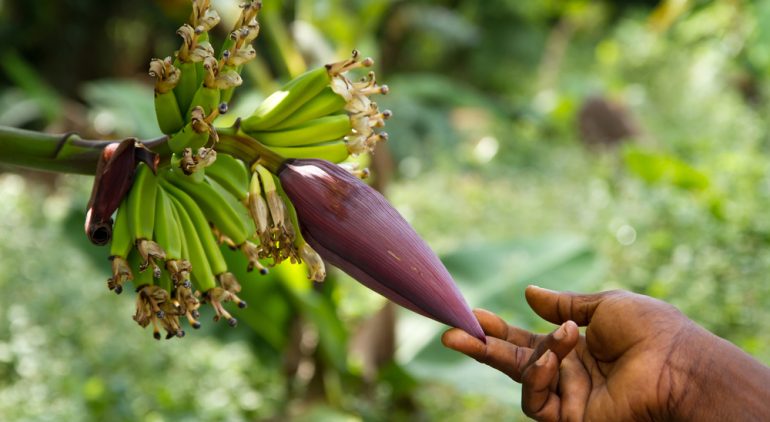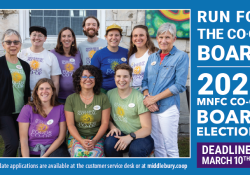
A Lament for Vanilla
This article first appeared in the Addison County Independent on March 17, 2022, as part of the Climate Matters: Perspectives on Change weekly column. There is no denying that food and the climate emergency are intertwined, a relationship made even more complicated by the geopolitical relationships between governments. I find it daunting to consider how my daily choices are affected by things happening thousands of miles away and in turn, how my choices might ripple outwards. I offer a reprint of this piece as a road map for considering how the foods we love and enjoy at the MNFC are situated within a deeper, global context. For an excellent, in-depth exploration of food and climate, I also recommend this article from The Guardian.
Each time I make a dessert that calls for vanilla, I cringe a little. A whole teaspoon, I find myself thinking, but that’s so much! And then after I wince, I feel a twinge of sadness, because I think that in a few decades it is possible that vanilla, real non-synthetic vanilla, might be gone, or at least extremely rare. We’ll only know it as something produced in a chemical factory, the taste becoming ever more like the smell of candles and body lotion. I imagine how birthday cakes will seem slightly…off.
As someone who cooks for a living, I think about food a lot, and I believed that I had considered how climate change would affect agriculture. I mean, I’m open to protein alternatives like insects, support local food systems, and try to make ethical consumer choices. That’s good, right? But I had never thought about what foods I would lose because of climate change until the fall of 2017. Around October that year, I placed a call to a vendor from work, looking to order a backup quart of vanilla, and I was warned that the price had gone up some. Now, price increases are normal in food service, an inevitability like taxes, but for vanilla to triple in price so quickly was unusual. Was this price gouging? An issue with shipping? No, nothing so mundane as the logistics of commerce. It was the weather. Cyclone Enawo in Madagascar, and then Hurricane Maria in Puerto Rico had decimated what some estimates placed at almost half of the world’s vanilla production.
We are going to lose some foods we currently find ubiquitous to the point of being boring —think about the last time you described someone as “vanilla.” Or consider how every grocery store in America, whether it is in Miami or Minnesota, has bananas. And coffee. And chocolate. All of these foods are grown in a specific swath within 10º-20º latitude of the equator, an area that is going to look drastically different within the next few decades. Vanilla extract is already an incredibly tricky thing to produce. It comes from an orchid that takes years to grow in specific tropical climates and requires hand pollination for every single flower. There are lots of synthetic varieties, but none is as complex to our nose and palate as the real thing. The reality is that modern food systems often supply the majority shares of individual crops, like vanilla, from relatively small regions. The production of many foods eaten worldwide is coming from just a handful of places. When those places are devastated by storms, rising sea levels, or drought, it means there is no other growing zone to pick up the slack.
And it won’t just be our diets that are affected. There are thousands and thousands of people working to grow, harvest, and process these foods so we can eat them year-round. Imagine what their lives are going to be like when their jobs and homes are further impacted by climate change. We know that we are going to see devastating storms more frequently in tropical areas, and as temperatures rise, those areas closest to the equator will become the least habitable. The countries located in this area are among the poorest in the world, and they will be forced to bear the brunt of our pollution. It is a stark picture that can unspool from baking brownies in a warm kitchen and worrying about the cost of a flavoring.
It saddens me further to say that there is nothing we can do about this. Even if we as a species were to make climate the single biggest priority for every world government today, we are still going to see many of these foods become rare. That damage has already been done, and we can’t stop it from happening. Columns like this one often include a “call to action,” some step or policy that could make a difference. But in addition to pressuring world leaders and changing our lifestyles, we need to confront—often and publicly—that we have made irrevocable changes to our planet that cannot be fixed.
See, it’s not just about taking action now, though there is lots of room for that, too. We have to begin to make plans for the future that we are guaranteed to have, a future with large groups of climate refugees. The same people who now produce our vanilla and bananas and coffee have been placed in an untenable situation and we have to figure out how we are going to take care of them because we helped create that situation. Currently, it is a lengthy and expensive process to immigrate into the U.S., one plagued by bureaucracy and red tape. Climate refugees are an unavoidable part of our future, which means we need to work now to change immigration. In some ways, this idea does give me hope, because if we can finally be moved to take care of each other, then maybe we can take care of the planet.
A friend and I joke that if we were to transport our spice cabinets to the 15th century, we would be the picture of wealth and riches. But I’ve started to change that daydream to imagine the riches my spice cabinet will represent to someone in just a few decades. Maybe it is silly to grieve for vanilla extract. But when I pour out each dark, fragrant spoonful, the flash of heartache I feel also comes with an awareness of what is to come, and what needs to happen.
Samantha Langevin is a Middlebury Natural Foods Co-op Board Member




